Deer-horse Hybrids
Mammalian Hybrids
|
I go here and there, culling out of several books the sentences that best please me, not to keep them (for I have no memory to retain them in), but to transplant them into this; where, to say the truth, they are no more mine than in their first places.
—Michel de Montaigne, Of Pedantry
|
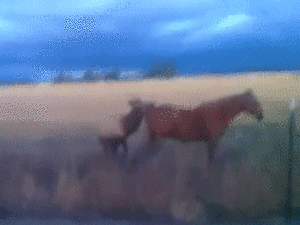 An alleged deer-horse hybrid. Note slender lower legs and deerlike tail. Contemporary reports claimed that the hooves of this animal, foaled by a mare, were pointed and “partially double” (i.e., cloven). (Artist: George Landseer).
An alleged deer-horse hybrid. Note slender lower legs and deerlike tail. Contemporary reports claimed that the hooves of this animal, foaled by a mare, were pointed and “partially double” (i.e., cloven). (Artist: George Landseer). 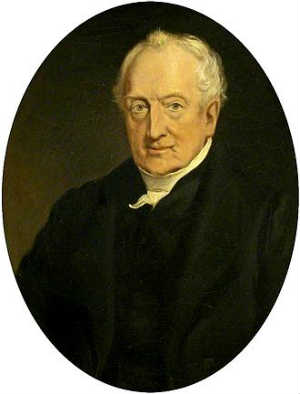 Richard Fowler (1767-1863), a physician and a fellow of the Royal Society, occupied a leading position in Salisbury for many years.
Richard Fowler (1767-1863), a physician and a fellow of the Royal Society, occupied a leading position in Salisbury for many years.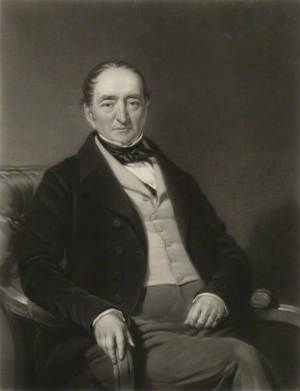 Colonel Edward Pery Buckley (1796-1873), later General Edward Pery Buckley, was attached to the courts of both George III and Queen Victoria. He served the latter as her Equerry (stable master) and had extensive knowledge of horses. He also was a member of Parliament, his position as Keeper of the New Forest being only one of many roles he played in public service.
Colonel Edward Pery Buckley (1796-1873), later General Edward Pery Buckley, was attached to the courts of both George III and Queen Victoria. He served the latter as her Equerry (stable master) and had extensive knowledge of horses. He also was a member of Parliament, his position as Keeper of the New Forest being only one of many roles he played in public service.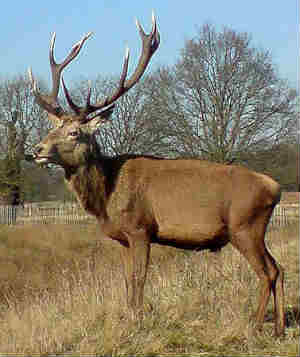 Red Deer (Cervus elaphus), known also as an Elk or Wapiti in North America.
Red Deer (Cervus elaphus), known also as an Elk or Wapiti in North America.
This cross is not so well attested as the similar cross cow x horse, but various reports about deer-horse hybrids do exist in the older literature, nearly all of which allege mating of Cervus elaphus stags with mares.
New Forest. One such account, which originally appeared in the Dec. 9, 1848 issue of the Illustrated London News accompanied by the drawing at right, reads as follows:
REMARKABLE HYBRID
This remarkable filly (seven months old) was found a short time since in the New Forest, and is evidently of a mixed breed, between the horse and the deer. The mother (a pony mare) was observed to associate with some red deer stags in the New Forest for some months, and, at last, this foal was seen by her side. The nose shows a proximity both to the stag and the horse; her forehead is round, like that of the deer; legs slender and distinctly double; hoofs pointed, and partly double; colour brown, lighter under the belly [as in a deer]; tail like a deer.
This extraordinary animal is the property of T. G. Attwater, Esq., of Attwater, at the village of Bodenham, three miles from Salisbury. Dr. Fowler, of that city has inspected the hybrid, and is quite satisfied with the correctness of the preceding statement; and Colonel Buckley (a Keeper of the New Forest) has likewise seen that animal, and is of a similar opinion.
In a separate contemporary report, Volume 8 (issue 1, p. 36, Jan. 1849) of the American Agriculturalist quotes the Sherborne Journal as follows:
Horses do not chew cud, but deer do. So this animal, born of a mare, exhibited a trait characteristic of deer and other ruminant artiodactyls, animals generally considered only distantly related to horses, that is, horses and deer are assigned to different mammalian orders (Perissodactyla and Artiodactyla, respectively).
The presence of the following entry in Sharp’s A New Gazetteer, Or, Topographical Dictionary of the British Islands and Narrow Seas (1852, vol. I, p. 86) suggests that the owner of this animal attained a fairly high level of notoriety:
In his book, The Origin of Life (1880, p. 474), Dr. Frederick Hollick (1818-1880), a renowned American physician, described the Attwater animal as
For an additional description of this animal see Dunglison (1850, pp. 468-469).
Williston, North Dakota. A “colt” with the head of a deer was reported in the Devils Lake, North Dakota, World (May 24, 1922, p. 8, col. 3):
COLT WITH DEER HEAD
FREAK NEAR WILLISTON
Osseo, Minnesota. From the San Bernadino, California, News (April 29, 1914, p. 1; ||yyhdefmv):
PART DEER, PART HORSE, TO BE ON TRACK
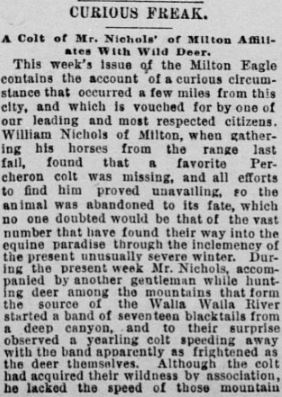
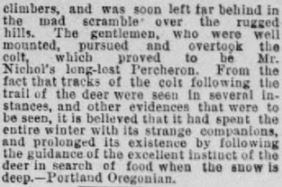 An article about a horse that went feral and spent the winter with a herd of deer. The report appeared in the San Francisco, California, Morning Call (Apr. 29, 1890, p. 8, cols. 5 & 6).
An article about a horse that went feral and spent the winter with a herd of deer. The report appeared in the San Francisco, California, Morning Call (Apr. 29, 1890, p. 8, cols. 5 & 6).
Though the notice does not specify the animal’s parentage, there would have been only two kinds of deer present in North Dakota, elk (Cervus elaphus) and white-tailed deer (Odocoileus virginianus). Since the latter would likely be too small to easily mount a mare, the former is the more likely candidate for the creature’s sire.
St. Joseph, Missouri. A “colt” with deer horns was reported in the Warren, Ohio, Western Reserve Chronicle (Aug. 10, 1870, p. 4, col. 3):
Elk were still present in Missouri in 1870, although they later became extinct there (they have now been reintroduced). White-tailed deer have always been present there.
Berlin. A different instance of a deer-horse is alleged in the Edinburgh New Philosophical Journal (1827, p. 390), which contains a brief report about such a hybrid entitled, “Extract of a Letter to M. de Férussac, dated Berlin, 27th January, 1827.” It reads as follows:
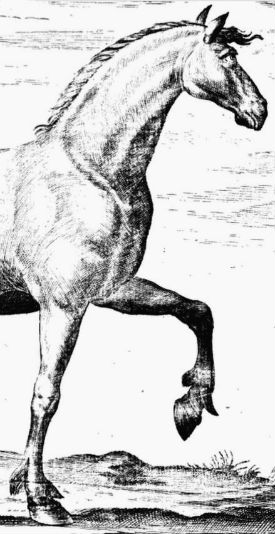 A horse with parasitic deer hooves (Adlersflügel 1703, fig. 24). One explanation for the presence of deer hooves in a horse is that the animal was a deer-horse hybrid.
A horse with parasitic deer hooves (Adlersflügel 1703, fig. 24). One explanation for the presence of deer hooves in a horse is that the animal was a deer-horse hybrid.
For similar accounts, see also: Ackermann (1898, p. 61); Anonymous 18271. 1827b (cited by Bronn 1847, p. 167). However, all of these trace to the anonymous letter just quoted.
Adlersflügel. In the 1703 edition of his Stuterey, (Stud Breeding), a manual on horse breeding, Georg Simon Winter von Adlersflügel, pictures a horse, which he says he not only saw, but also rode and trained himself (Adlersflügel 1703, p. 136), that had cloven, deer-like hooves protruding from the pastern on both front legs just above the ordinary hooves (pictured at right). Adlersflügel was a master equestrian and the author of numerous books on equine medicine. According to Adlersflügel’s account, a farmer had put the mother mare out to graze and she was covered by a red deer stag in rut.
Royal Menagerie. In addition, Adlersflügel alleges (p. 138) that, not a deer-horse hybrid, but rather that a related hybrid, a deer-donkey, was present in London’s Royal Menagerie during the early 1680s. He includes a picture of the animal:
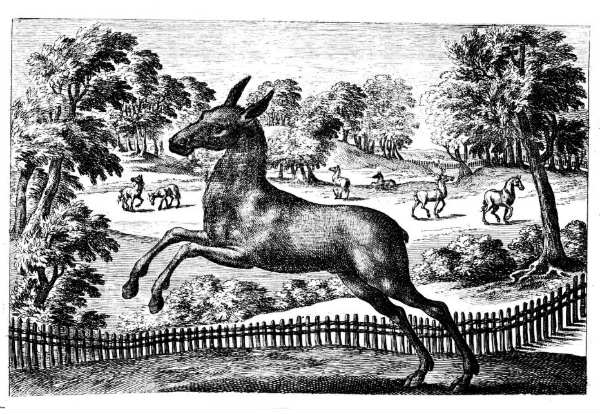 A deer-donkey hybrid supposedly foaled in the Royal Menagerie (London) in 1681 (source: Adlersflügel 1703).
A deer-donkey hybrid supposedly foaled in the Royal Menagerie (London) in 1681 (source: Adlersflügel 1703).
Make your own! Adlersflügel gives the following instructions, rendered here in English translation, on how to obtain such hybrids, which may be of use to anyone today who might want to experiment with this cross (Adlersflügel 1703, pp. 128-129): “Begin by keeping a stag and a pregnant mare, who will foal in August, together in a park throughout the spring and summer, through the time of her delivery, so that they will get used to each other’s company. There must be no other beast present. In this way, when the mare, having foaled, comes into heat, the stag, when he enters rut without access to does, will mount and service the mare. And she, being lusty and in heat, will readily accept his advances.”
Deer-horse hybrids: Early reports
Two other, earlier authors mention deer-horse hybrids.
Louis XII. And the Swiss surgeon Jakob Ruf (1500-1558) mentions a separate instance of a deer-horse hybrid (De Conceptu et Generatione Hominis, Tiguri, 1587, p. 48):
[Translated by E. M. McCarthy. Original Latin.]
The “King Louis” mentioned by Ruf was probably Louis XII (reigned 1498-1515), given that no other French king by the name of Louis reigned during Ruf’s lifetime.
Other
Artiodactyl-equid Crosses:
Gerald of Wales. In his Journey through Wales (twelfth century, translated by Sir Richard Colt Hoare), Gerald of Wales says a mare mated with a stag “and produced an animal of wonderful speed, resembling a horse before and a stag behind.”
Reports compared. Thus, in several of the older accounts of deer-horse hybrids, it is the anterior portion of the hybrid that is horse-like, while the posterior is deer-like, which is the same configuration as Adlersflügel’s deer-donkey hybrid pictured above. However, the alleged conformation of the Attwater animal pictured at the top of this page seems to have been the opposite, except in that that animal was supposed to have had the tail of a deer.
A non-reversible cross? Also, in all cases it is stated that a stag crossed with a mare. Many hybrid crosses are directional in this way, that is, either mating doesn’t occur when the cross is reversed (in the present case the reverse, or reciprocal, cross would be a stallion mated with a doe) or they don’t yield a hybrid even when insemination does occur. It’s perhaps worth mentioning, as well, that some distant crosses require many inseminations to produce a single mature hybrid. For example, attempts to cross turkeys with chickens have shown that about 1,000 artificial inseminations of hens with turkey semen are required to produce a single adult hybrid.
An unverified modern account
Odocoileus virginianus
An anonymous participant in a now defunct page of a hunting and fishing forum posted the picture of an alleged deer-horse hybrid shown at right. When accused of faking the picture, he or she responded as follows:
Lower down on the same page, he or she continued as follows:
Given that the White-tailed Deer is the only cervid native to Georgia, the cross alleged would presumably be Odocoileus virginianus × Equus caballus.
From the standpoint of taxonomic classification, deer-horse hybrids are similar to cow-horse hybrids, a cross that has been reported far more often than deer-horse, probably because both cattle and horses are common domestic animals. Another type of deer-horse hybrid (moose × horse) has been alleged, but requires confirmation.
By the same author: Handbook of Avian Hybrids of the World, Oxford University Press (2006).
Old ad offering a deer-donkey hybrid for sale >>
Most shared on Macroevolution.net:
Human Origins: Are we hybrids?
On the Origins of New Forms of Life
Mammalian Hybrids
Cat-rabbit Hybrids: Fact or fiction?
Famous Biologists
Dog-cow Hybrids
Georges Cuvier: A Biography
Prothero: A Rebuttal
Branches of Biology
Dog-fox Hybrids
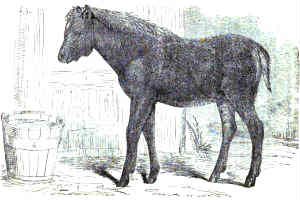 Enlarge
Enlarge